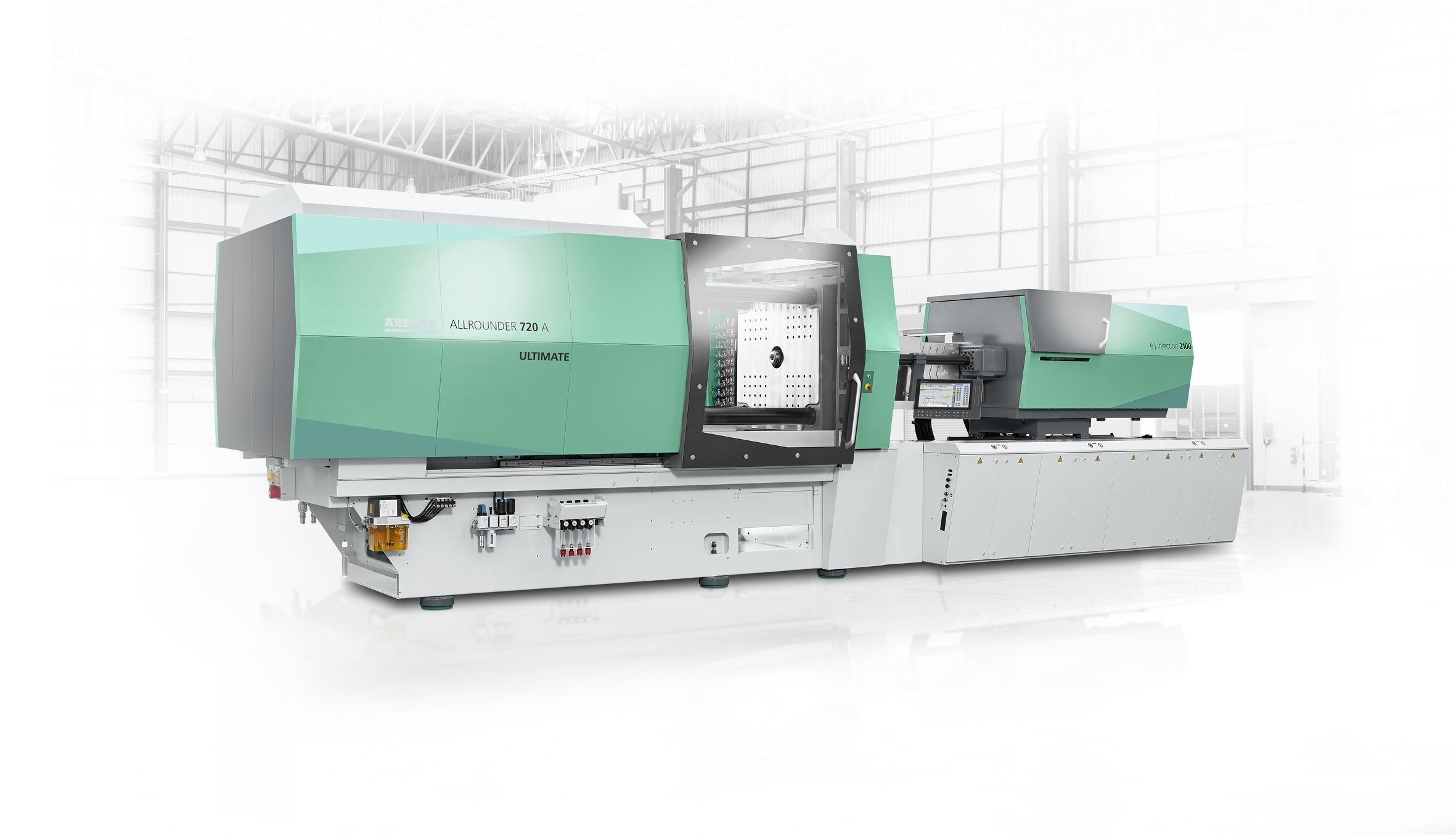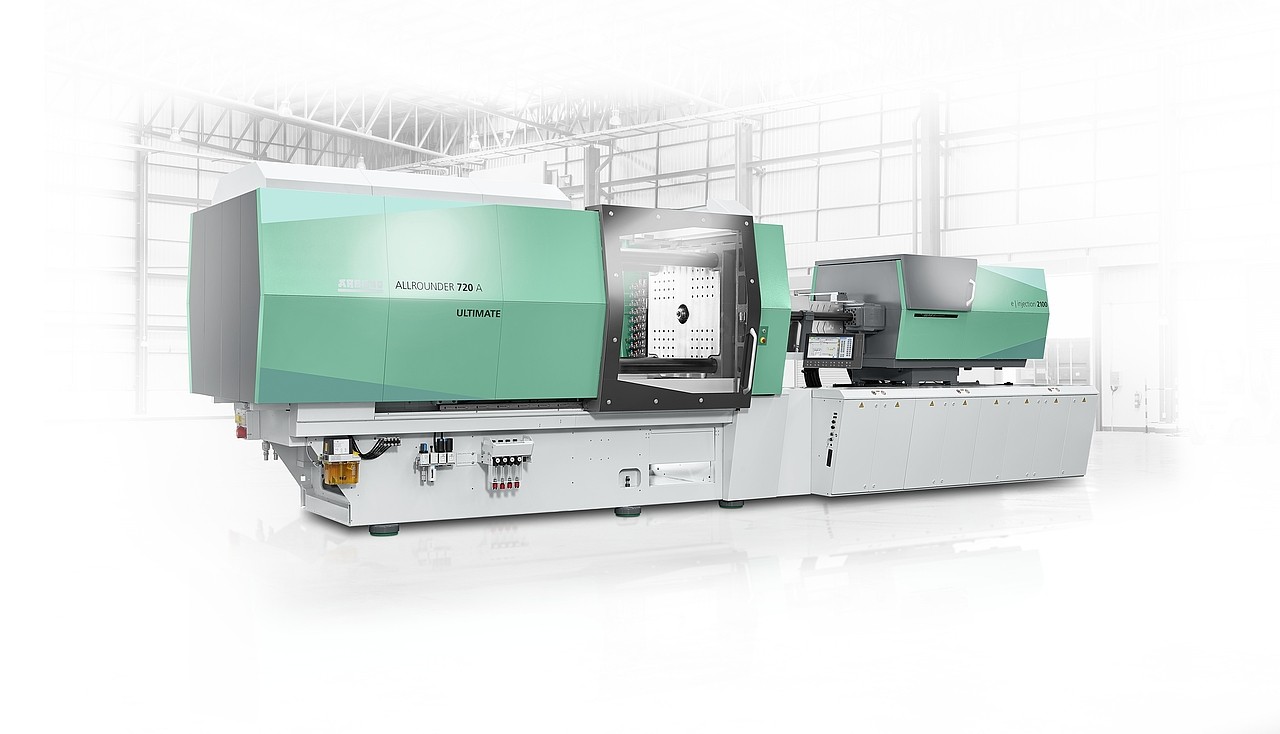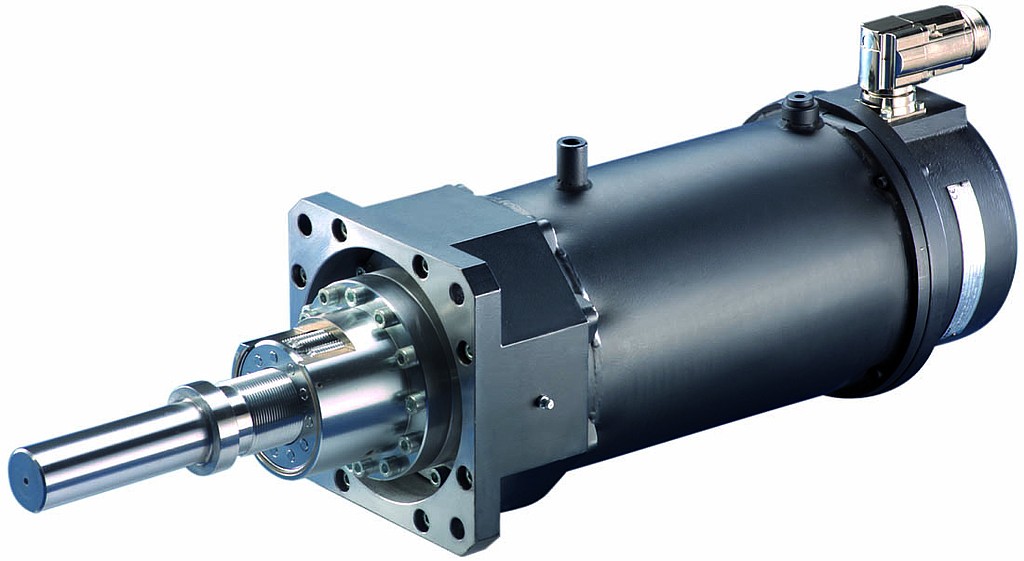ARBURG saves space in its injection moulding machines
Thanks to the compact, powerful hollow-shaft synchronous servo motors by AMKmotion, ARBURG is able to save space in its ALLROUNDER electric injection moulding machines.

ARBURG was looking for a partner to develop a modular, compact and powerful servomotor with a long service life.
The machine axes in the ALLROUNDER are moved via electric hollow-shaft synchronous servomotors.
The compact, liquid-cooled drive solution from the specialists in Kirchheim unter Teck ensures a very compact movement transformation, making the hollow-shaft motor economical and efficient.


The hollow shaft synchronous servo motors from AMKmotion convert rotation into linear motion. They are ideal for high axial loads.
The first contacts between AMKmotion, then AMK Arnold Müller GmbH & Co. KG, and Arburg date back to 1994. Even at this time, AMK was busy developing liquid-cooled drive motors – a technology that Arburg was keen to use in its electric injection moulding machines. The use of liquid-cooled motors was the obvious choice. Another issue was the compact motor design. Arburg was clear on its requirements, and AMK was the perfect partner to put them into practice. This led to a series of hollow-shaft synchronous servo motors under the product name SKT – with dynamics and performance, which are not just of interest for the design of injection moulding machines.
Simply explained, a hollow-shaft motor is a special servo drive unit that has a through hole in the centre axis of the motor to accommodate a drive spindle that converts rotary motion to linear motion. In this way, it was possible to save on attachment parts and installation space, making a much more compact design feasible for the machines into which this type of motor was to be integrated. AMKmotion’s hollow-shaft motors are still used today, especially for the mechanical drive to feed the mould movement, i.e. the movements of the clamping unit on Arburg injection moulding machines. The SKT motors require up to a third less space, mainly due to the fact that the drive spindle penetrates through the motor. This makes for a very compact movement transformation.
Hollow-shaft technology is primarily about converting a rotary motion into a linear motion. The bearings absorb the axial forces, while the necessary force build-up on the linear path is provided by the spindle. In the process, the spindle nut rotates and the spindle moves axially. Depending on the application, however, the reverse is also technically possible, i.e. the spindle rotates, while the motor and spindle nut move. This spindle-nut system turns the SKT hollow-shaft motor into a ready-to-use linear drive, making it an efficient alternative to pneumatic or hydraulic drives. “The brain of this servo drive”, as Marc Scheer, Head of Key Account Management at AMKmotion, puts it, “is the multiturn absolute encoder. It can be used to realise different speeds so sensitively that the required travel distances of the servo motors can be defined and approached with a high degree of precision. Via the absolute encoder, the drive system can be moved with a high degree of precision, whereby positions which have been moved to and set can be stored as well. After the machines are switched on again, the encoder knows immediately at which position it is. The advantage here: no further measurement technology is necessary for the linear movement. Energy input is only required for the movement itself, which makes the hollow-shaft motor economical and efficient, thanks to the fact that the operating point can be designed to be very precise.”
Powerful servo motors were a must right from the outset for the electric Arburg ALLROUNDERs Alldrive, Edrive, Golden Electric and the hybrid ALLROUNDER Hidrive They were to occupy as little space as possible inside the machines, so they needed to be compact in design. In addition, optimum cooling had to be provided so as to ensure the longest possible service life. Some of AMKmotion’s competitors were also capable of making servo drives at the time, but even then the company was one of the pioneers of this technology. But it was only the drive, control and automation specialists in Kirchheim unter Teck who were willing to fully engage with Arburg’s design requirements. This partnership subsequently resulted in very close collaboration. In the course of 15 years of development to date, expertise on both sides has fed into the technology of the SKT hollow-shaft motors. In addition, there was the shared vision of smaller installation space while still maintaining optimum energy performance. As a result of this, the Arburg entrepreneurial families Hehl and Keinath took the opportunity in 2021 to take over AMK’s Drives and Automation division from Zhongding Holding Europe GmbH. The Chinese investor was looking to sell this business segment at the time due to strategic changes. So AMKmotion is now a sibling company within the Arburg family.
The second generation motors resulting from the cooperation with Arburg were then “designed into” the machines, so to speak, so they were also scalable in terms of output levels and precisely adaptable to the size of the Arburg ALLROUNDERs. With liquid cooling, the heat generated by the motor is dissipated directly where it is generated and can be reused – for heating other consumers and rooms, for example. This sustainably increases the service life of the hollow-shaft motors. What is more, the material of the motor magnets and their arrangement are precisely adapted to the application requirements for even higher performance. All in all, the combination of waste heat utilisation and extended running ensures much increased efficiency. The compact, modular mechatronic functional units consist of a powerful servo motor with integrated axial bearing and multiturn absolute encoder.
The second step in the development of the compact hollow-shaft motors – the realisation of liquid-cooled servo converters – was also primarily due to the further optimisation of space requirements. The heat dissipation via the so-called “cold plate method” is also interesting. This process works as follows: the converter transfers the heat to the cooling plate, which in turn transfers it to the cooling liquid flowing through. The connections of the cooling plate are located outside on the back of the control cabinet. As Marc Scheer says: “To our knowledge there has never been a cooling failure – either in the motors or the servo converters.”
In a nutshell, there are tangible benefits to this technology. These include the following:
Compared to a belt-driven solution, for example, hollow-shaft motors offer other impressive features, too:
Due to the above-mentioned product characteristics and the principle of combining maximum performance with compact external dimensions, the hollow-shaft motors are of interest to AMKmotion customers in other mechanical engineering sectors, too. This applies to die-casting machines and presses of all kinds as well as special applications such as rotary feedthroughs, for example. High loads can be moved with a high level of precision at varying speeds, such as in the case of electric presses. For these applications, the motors do not necessarily have to be liquid-cooled; convection cooling is also possible.
As such, the joint development work between Arburg and AMKmotion can be described as having created a win-win situation right from the outset. Arburg obtained precisely the liquid-cooled hollow-shaft motors and converters for its electric and hybrid machines that met all its needs in terms of dynamic performance and installation benefits. AMKmotion was able to expand its hollow-shaft motors into the SKT product family, which in this form are also of great interest to other mechanical engineering customers. In the case of liquid-cooled converters, AMKmotion even has a unique selling point on the market: the ratio between required installation space and power output remains unrivalled. Practical use of this generation of motors and converters in Arburg’s ALLROUNDER injection moulding machines has been very successful and problem-free to date. Michael Kaupp works in software development at Arburg and has long been involved in the development partnership between the two companies. He has no doubt: “Arburg still has potential for the use of this type of drive system.”